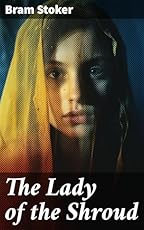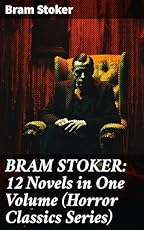Dracula
In the mountains of Transylvania there stands a castle. It is the home of Count Dracula - a dark, lonely place, and at night the wolves howl around the walls. In the year 1875 Jonathan Harker comes from England to do business with the Count. But Jonathan does not feel comfortable at Castle Dracula. Strange things happen at night, and very soon, he begins to feel afraid. And he is right to be afraid, because Count Dracula is one of the U-Dead - a vampire that drinks the blood of living people . . .
Dracula by Bram Stoker is a timeless classic of Gothic horror literature. First published in 1897, the novel tells the story of a group of people in England who are terrorized by the Count Dracula, a Transylvanian vampire. The novel is written in epistolary form, with the story being told through the letters and journal entries of the characters. This epistolary style gives the novel a sense of immediacy and suspense, as the reader is constantly piecing together the events of the story from the various perspectives of the characters.
One of the things that makes Dracula so enduring is its atmosphere. Stoker masterfully creates a sense of dread and suspense, using vivid descriptions of the Transylvanian setting, the Count's castle, and the vampire's attacks. The novel is also full of symbolism, with the vampire representing a variety of things, such as evil, sexuality, and the fear of the unknown.
The characters in Dracula are also well-developed and memorable. The main protagonist, Jonathan Harker, is a young lawyer who is sent to Transylvania to meet with Count Dracula. Harker is a brave and resourceful character, but he is also naive and makes some mistakes that put him in danger. The other main characters, such as Dr. Abraham Van Helsing and Mina Murray, are also well-drawn and add to the suspense of the story.
Dracula has been adapted into many different films and television shows, but the novel itself remains the definitive version of the story. If you are looking for a classic Gothic horror novel that will keep you up at night, Dracula is a must-read.
Here are some of the things that I liked about Dracula:
- The suspenseful atmosphere
- The well-developed characters
- The symbolism
- The epistolary style
Here are some of the things that I didn't like about Dracula:
- The slow pace of the story in some parts
- The use of some outdated language
Overall, I would highly recommend Dracula to anyone who enjoys Gothic horror fiction.
How can you read this book?
Click these simple buttons to read this book today.
Bram Stoker, Writer ![]()
Master of the Macabre
Welcome to the intriguing world of Bram Stoker, a literary genius whose imagination has left an indelible mark on the horror genre. Born on November 8, 1847, in Clontarf, Dublin, Stoker would go on to become one of the most influential writers of the 19th century.
Bram Stoker, the Irish author who gifted the world the iconic vampire Count Dracula, was much more than just a horror writer. He was a multifaceted personality who thrived in the vibrant world of late-19th-century London, juggling multiple roles as a novelist, theater manager, critic, and personal assistant to the renowned actor Sir Henry Irving.
Early Life and Influences:
Born in Dublin in 1847, Stoker's childhood was marked by illness. Confined to his bed for years, he found solace in books and storytelling, a passion that would fuel his future endeavors. After studying at Trinity College Dublin, Stoker embarked on a journalistic career, honing his writing skills and immersing himself in the cultural and literary scene of the city.
Stoker's early life was marked by a keen interest in the arts, and he pursued a degree in mathematics at Trinity College, Dublin. However, it was his passion for the theater that ultimately shaped his career trajectory. Stoker worked as a civil servant but found his true calling as the manager of London's Lyceum Theatre, where he collaborated with the legendary actor Sir Henry Irving.
The Lyceum Theatre and Sir Henry Irving:
In 1878, Stoker's life took a pivotal turn when he met the charismatic actor Henry Irving. He became Irving's personal assistant and business manager at the legendary Lyceum Theatre, London. This position thrust Stoker into the heart of the theatrical world, exposing him to creative minds, extravagant productions, and the captivating power of performance.
While Stoker's contributions to the theater were significant, his literary legacy is forever tied to his iconic Gothic novel, "Dracula." Published in 1897, "Dracula" introduced the world to the charismatic and fearsome Count Dracula, forever changing the landscape of vampire literature. Stoker's meticulous research and vivid storytelling brought to life a tale of horror, suspense, and the eternal battle between good and evil.
Beyond Dracula:
While Dracula's chilling narrative overshadows much of his other work, Stoker was a prolific writer who penned numerous novels, short stories, essays, and reviews. His other notable works include "The Jewel of the Seven Stars," "Miss Dracula," and "The Lady of the Shroud," all showcasing his fascination with the gothic, the supernatural, and the mysteries of the human psyche.
The Birth of Dracula:
In 1897, Stoker unleashed his magnum opus, "Dracula." The novel, inspired by Irish folklore, Eastern European mythology, and Stoker's own research on vampirism, became an instant sensation. With its epistolary format, vivid characters, and suspenseful plot, "Dracula" redefined the vampire myth and left an indelible mark on popular culture.
Legacy:
Bram Stoker passed away on April 20, 1912, leaving behind a legacy that extends far beyond his mortal years. His influence on the horror genre endures, with "Dracula" remaining a timeless masterpiece that continues to terrify and enchant audiences.
Bram Stoker's influence extends far beyond the realm of literature. "Dracula" has been adapted countless times for film, television, theater, and various other media, cementing the Count's image as the quintessential vampire. Stoker's work continues to inspire contemporary writers, filmmakers, and artists, showcasing the enduring power of his macabre imagination.
Beyond the Bio:
- A Man of Many Hats: Stoker's interests and talents extended beyond writing. He was an athlete, a photographer, and an amateur musician, showcasing his well-rounded personality and thirst for knowledge.
- Irish Roots: Despite achieving success in London, Stoker never forgot his Irish heritage. He incorporated Irish folklore and mythology into his writing, adding a unique layer to his narratives.
- The Mysterious Stoker: While much is known about Stoker's life and work, some aspects remain shrouded in mystery. His personal life, particularly his relationship with his wife Florence, continues to be a subject of speculation and intrigue.
Bram Stoker's legacy lives on not just in the blood-curdling tales he wove, but also in the multifaceted persona he embodied. He was a man of letters, a theatrical mastermind, and a keen observer of the human condition, all woven together by a dark and captivating imagination. By delving deeper into his life and work, we gain a richer understanding not only of the master of the macabre but also of the fascinating era in which he lived and thrived.
Explore the cryptic corridors of Stoker's literary realm as we delve into the life and works of this iconic author. Join us on a journey through the pages of his chilling tales, and discover the man behind the immortal Count Dracula.





